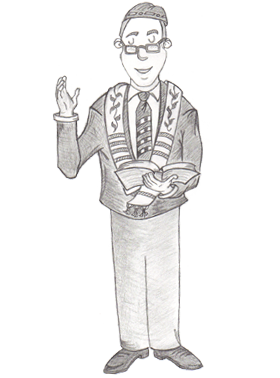The Ceremony
There are three traditional parts to a bris: the milah (circumcision), the naming, and the seudat mitzvah (celebratory meal). There are certain required elements to a proper bris ceremony yet there is ample opportunity for embellishment and creativity. Dr. Oppenheim strives to make each ceremony unique, insightful and truly special. What follows below is a general overview of what may occur.
The Milah (circumcision) Ceremony
The bris ceremony typically commences with your child being brought into the room by a honored participant called the “kvatterin” (godmother) and “kvatter” (godfather). These are purely ceremonial honors and have no religious significance or requirements as in other faiths. Once the child enters the room, every one says the traditional welcoming blessing “Baruch Haba” (“Blessed he who enters”). The baby is optionally handed to other honored participants and then placed on the chair of Elijah.
The mohel recites a prayer honoring Elijah and reminding us of his significance.
The baby is then placed in the lap of the “sandek” which is the person who is responsible for watching over the baby during the circumcision procedure. This is considered the most honored position of the ceremony. This honor is often bestowed upon a grandfather.
The parents recite some blessings and then are asked by the mohel if they wish for him to serve as their proxy to fulfill the commandment to have their son circumcised.
The mohel then begins performing the surgical procedure and he recites the blessing over the circumcision just before the cut is made.
After the procedure is completed and the wound is dressed, the parents recite a prayer recognizing that they have fulfilled the obligation to enter their son into the covenant of Abraham.
The assembled guests recite a prayer of hope for the child expressing their desire for him to become learned of Torah and Jewish ways, to get married and procreate, and to have a life full of good deeds.
A Mishebeirach prayer of healing is recited followed by a Kiddush and a benediction prayer.
The Naming Ceremony
Once the child has been circumcised, the naming ceremony follows. Either a “standing sandek” (another honored position) or a parent holds the baby during the naming ceremony. After the mohel formally announces the childs Hebrew name the parents offer some words as to the name’s derivation and its personal meaning.
Additional readings may be recited by honored participants.
The Shehechayanu is recited by all gathered.
The mohel offers the Priestly Benediction.
The ceremony concludes with a traditional singing of "Siman Tov U’Mazel Tov" (May good signs and fortune light your way).
The Seudat Mitzvah
As the ceremony concludes, the guests are invited to partake in the celebratory meal.
